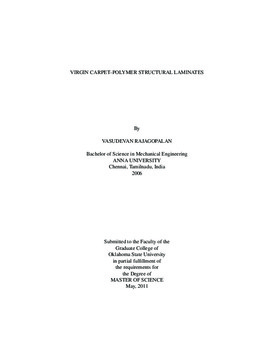| dc.description.abstract | Post-consumer carpet waste recycling is in its infant stage in the United States. Currently, a number of initiatives have been taken to recycle carpet waste with an effort to divert away from landfill and incineration. Some of the current and previous methods suggest that waste carpets can be chopped or shredded and reused, or melt blended to form into a desired product shape. However, none of these methods was simple enough to reduce the energy and the total cost involved. A recent technique proposed by Singh et~ al. (Patent pending), suggests the use of simple resin infusion technique to convert the post-consumer carpet waste into useful structural laminates. The initial study that was done on nylon fiber based post-consumer waste carpet--structural laminates, using vacuum infusion technique, showed promising results on mechanical and physical properties. In an attempt to perceive the deterioration of carpet fibers upon its long usage, this study has been primarily aimed at establishing reference properties using virgin carpet--polymer based composites that can further be utilized to create a comprehensive database. Most of the manufactured carpets today consist of one of these six pile fibers: nylon, olefin, polyester, acrylic, cotton, or wool. Of these, nylon and olefin are by far the best all-around materials with better multi-resistant properties. This study is directed at utilizing the three dimensional architecture of virgin nylon and olefin fiber based carpets, and converting them into realtime-application based structural laminates. Two VARtm-able epoxy resins, SC 79 and vinyl ester, are employed as matrix for making such laminates. Materials are fabricated using a simple, vacuum infusion based, fabrication technique. Subsequently, these structural laminates are tested for different mechanical and physical properties. Using the test results, a reference property is established, and a clear understanding of the failure mechanisms of the discussed carpet--polymers with two different laminate design configuration styles, BFFB and FBBF, is achieved. [Note: BFFB -- Backing-Face fiber-Face fiber-Backing, FBBF -- Face fiber-Backing-Backing-Face fiber.] | |
